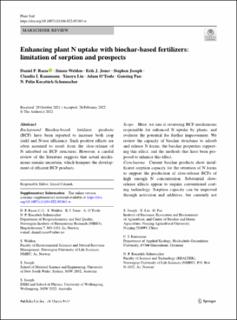| dc.contributor.author | Rasse, Daniel | |
| dc.contributor.author | Weldon, Simon Mark | |
| dc.contributor.author | Joner, Erik | |
| dc.contributor.author | Joseph, Stephen | |
| dc.contributor.author | Kammann, Claudia I. | |
| dc.contributor.author | Liu, Xiaoyu | |
| dc.contributor.author | O'Toole, Adam | |
| dc.contributor.author | Pan, Genxing | |
| dc.contributor.author | Kocatürk Schumacher, Nazli Pelin | |
| dc.date.accessioned | 2022-04-01T15:59:20Z | |
| dc.date.available | 2022-04-01T15:59:20Z | |
| dc.date.created | 2022-03-31T10:04:38Z | |
| dc.date.issued | 2022-03-24 | |
| dc.identifier.citation | Rasse, D. P., Weldon, S., Joner, E. J., Joseph, S., Kammann, C. I., Liu, X., O’Toole, A., Pan, G., & Kocatürk-Schumacher, N. P. (2022). Enhancing plant N uptake with biochar-based fertilizers: limitation of sorption and prospects. Plant and Soil. | en_US |
| dc.identifier.issn | 0032-079X | |
| dc.identifier.uri | https://hdl.handle.net/11250/2989357 | |
| dc.description.abstract | Background Biochar-based fertilizer products (BCF) have been reported to increase both crop yield and N-use efficiency. Such positive effects are often assumed to result from the slow-release of N adsorbed on BCF structures. However, a careful review of the literature suggests that actual mechanisms remain uncertain, which hampers the development of efficient BCF products. Scope Here, we aim at reviewing BCF mechanisms responsible for enhanced N uptake by plants, and evaluate the potential for further improvement. We review the capacity of biochar structures to adsorb and release N forms, the biochar properties supporting this effect, and the methods that have been proposed to enhance this effect. Conclusions Current biochar products show insufficient sorption capacity for the retention of N forms to support the production of slow-release BCFs of high enough N concentration. Substantial slow-release effects appear to require conventional coating technology. Sorption capacity can be improved through activation and additives, but currently not to the extent needed for concentrated BCFs. Positive effects of commercial BCFs containing small amount of biochar appear to result from pyrolysis-derived biostimulants. Our review highlights three prospects for improving N retention: 1) sorption of NH3 gas on specifically activated biochar, 2) synergies between biochar and clay porosities, which might provide economical sorption enhancement, and 3) physical loading of solid N forms within biochar. Beyond proof of concept, quantitative nutrient studies are needed to ascertain that potential future BCFs deliver expected effects on both slow-release and N use efficiency. | en_US |
| dc.language.iso | eng | en_US |
| dc.publisher | Springer Nature | en_US |
| dc.rights | Navngivelse 4.0 Internasjonal | * |
| dc.rights.uri | http://creativecommons.org/licenses/by/4.0/deed.no | * |
| dc.title | Enhancing plant N uptake with biochar-based fertilizers: limitation of sorption and prospects | en_US |
| dc.type | Peer reviewed | en_US |
| dc.type | Journal article | en_US |
| dc.description.version | publishedVersion | en_US |
| dc.rights.holder | © The Author(s) 2022 | en_US |
| dc.source.pagenumber | 24 | en_US |
| dc.source.journal | Plant and Soil | en_US |
| dc.identifier.doi | 10.1007/s11104-022-05365-w | |
| dc.identifier.cristin | 2014036 | |
| dc.relation.project | Norges forskningsråd: 281113 | en_US |
| dc.relation.project | EC/H2020/652615 | en_US |
| cristin.ispublished | true | |
| cristin.fulltext | original | |
| cristin.qualitycode | 2 | |

